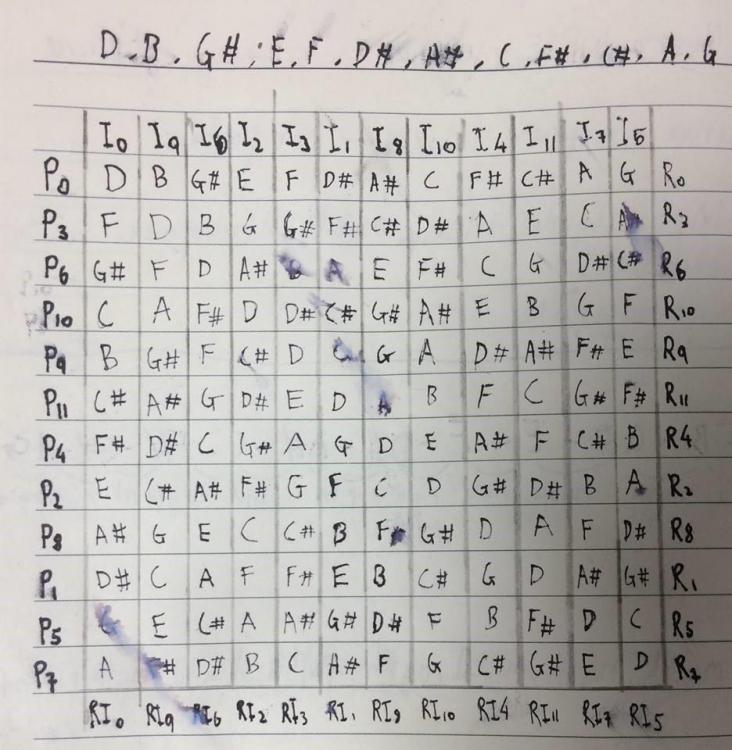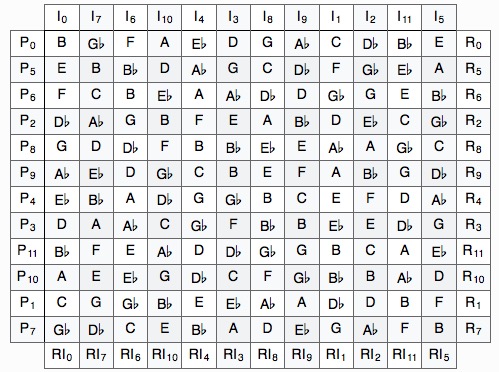Search the Community
Showing results for tags 'serial'.
-
**Re-uploaded due to file attaching issues** A piece written for a composition assignment. This piece is 12 tone and I have attached the tone row matrix I was working from. This is how I submitted it but I have a few issues with the tempi in certain parts as well as the general form. All feedback welcome ☺️
- 1 reply
-
- flute
- cor anglais
- (and 4 more)
-
This is just a trifle really. Started these about 2 months ago. The idea is a brief prelude written every morning. The first one plays around with a serial matrix -purposefully breaking the means at which the matrix is used to generate the material for a piece. The second one follows this same purposeful inconsideration of serial technique by juxtaposing the material from the matrix in a particular manner. Again, these two are mere trifles -serious pieces, but really just trifles. Note, I'm just learning musescore. I don't know the full ins and outs of making the scores look professional -so don't bother critiquing that!
-
This piece is in the Rondó Form. There is a main subject (tema principal) and three subordinate themes. So the structure is ABACADA, the A part has always been modified. I have used the "classical" atonal system described by Schönberg and "friends". The dodecaphonic matrix is this: Several series are combined to achieve the variation and to create tension and rest (they are not randomly combined, as many people think about atonality). The series are notated in the score. Rondó.pdf Rondó.mp3
-
It's been a while since I've been on here. I have put dreams of writing a symphony off until I can manage a small-scale piece (solo piano, for instance), and spent the month of June writing a little bit of something (new) each day. Got through thirty days and had some good ideas in the mix, but the largest problem I had was developing them beyond the 8-10 bars that I'd constructed. That's another issue. I wrote this and somewhat unintentionally expressed the train of thought of an entire day at work (between meetings) despite my efforts to condense it. In the interest of time, I will post the actual question at the end of said train here, and again at the end of my actual post: Based on what factors does one determine whether it is a work of genius, a flop, an acquired taste, or just the housecat prancing around on the Steinway in the living room? An extension of that question, and I suppose the real heart of my issue is, based upon what can I critique the works that I write using this method? What will be my goal in expression if it is not tonal? And now for how I got there. Also, I promise this post about 'atonal' or 'serial' or 'twelve-tone' music or whatever you want to call it is not to troll... but I can see how it may seem that way (or seem like a very amateur question, which not be out of character). In that regard, I recently started playing around with writing out some twelve-tone matrices. The issue I was having with developing or broadening or expanding motivic material lies partly with my imagination, but the root of that problem is probably more in my lack of music theory knowledge (i.e. my ability to use and manipulate the rules of harmony, voicing, etc.). I've studied entirely on my own and have a very good general understanding of (the most basic) harmony, the ideas and concept and treatment of sonata form, and the like, but to get in and start writing music, voicing chords, etc. proves very difficult for me, so it's slow going and very rudimentary. Back to Schoenberg and his twelve tones. In composing in this manner, one of the decisions left to a composer is removed, or at least greatly limited. Generally speaking (incredibly vaguely), a composer deals with a few things: pitch duration orchestration tempo dynamic harmonization intonation or attack Composing based on a twelve-tone row greatly limits if not eliminates the variables of pitch and harmony (obviously hexachords and vertical use of the series are not out of the question, but not with the freedom of choosing to use a minor/major/diminished/ninth chord, etc.), so the others play a much greater role in the style/interpretation feel of the piece. I am realizing that just from my writing out of the matrix. Just to clarify, I'm not talking about integral/total/multiple serialism like in Boulez's piano sonatas, for instance. Just the pitches and their sequences. So my question, ultimately, is this: in the tonal scheme, with tonics and dominants and tonal centers, it is very easy for even a total beginner to hear a piece like a Chopin nocturne or a Mozart sonata and 'understand' it emotionally to some degree or other (happy, sad, peaceful, etc.) because of its use of tonal expression. Even late Scriabin pieces, while highly chromatic, still make use of tonality to express emotion and feeling. People will rate the quality of the music, whether it is 'good' or 'bad', based on their ability to understand it, which as Milton Babbitt has pointed out, only happens in music and politics. My question then, is this (I did say that earlier) : since the average human innately understands the pentatonic scale and has some foundation for understanding "good" use of harmonies to some degree, he can identify with "good" music, or music that adheres to the rules of harmony (more advanced, even to the point of identifying and appreciating key changes, and modulations and their relationships to the tonic). Not being able to hear immediately the relationships between notes in a twelve tone series once we get to the inversion and retrograde, etc. how is one to distinguish "good" serial music from "bad"? I can listen to Schoenberg's op. 11 with some degree of appreciation, but it's a stretch. I have absolutely zero comprehension for Boulez's sonatas or anything by Babbitt, though. Based on what factors does one determine whether it is a work of genius, a flop, an acquired taste, a work with potential, or just the housecat prancing around on the Steinway in the living room? An extension of that question, and I suppose the real heart of my issue is, based upon what can I critique the works that I write using this method? What will be my goal in expression if it is not tonal? I suppose that is a subjective and individual question, but it still seems one worth asking. Thanks in advance for thoughts and ideas.
-
Oh hey everyone, I haven't been on this thing for ages. I am at uni now, studying composition among other things. For one of my assignments we have two different ways we can compose our piece. 1st - Using archetypal shapes or phrases that get repeated with variation, in the style of Syrinx by Debussy. 2nd - Talea and Color in the style of Messiaen. Chord patterns that phase in and out of the pulse of the beat. Here is my idea, i'm going with option 2 btw. I have a 12 tone row which is basically a set of four major and minor triads. The idea is that the base holds the route, once the rest of the triad is played, the bass then moves to the route of the next chord, basically creating three chords per bar rather than two. Here's an example. As you can see in the attached file, it appears as though the chords are: (F+ maj) - (space) - (Cmaj) When in reality because of the held on F+ there are three chords (F+maj) - (F+, E, G) - (Cmaj). The piece continues like this with the route in the bass and the response in the violin and viola being separated. Eventually the viola's rhythm is augmented (x 0.5) and the violin's diminished (x0.5) which creates the middle and the top line phasing in and out with the bass line. Sorry if that's a lot to take in, but is this an example of a talea and color? Is this technically an example of a modern passacaglia? I need to know i'm on the right track. Thanks






